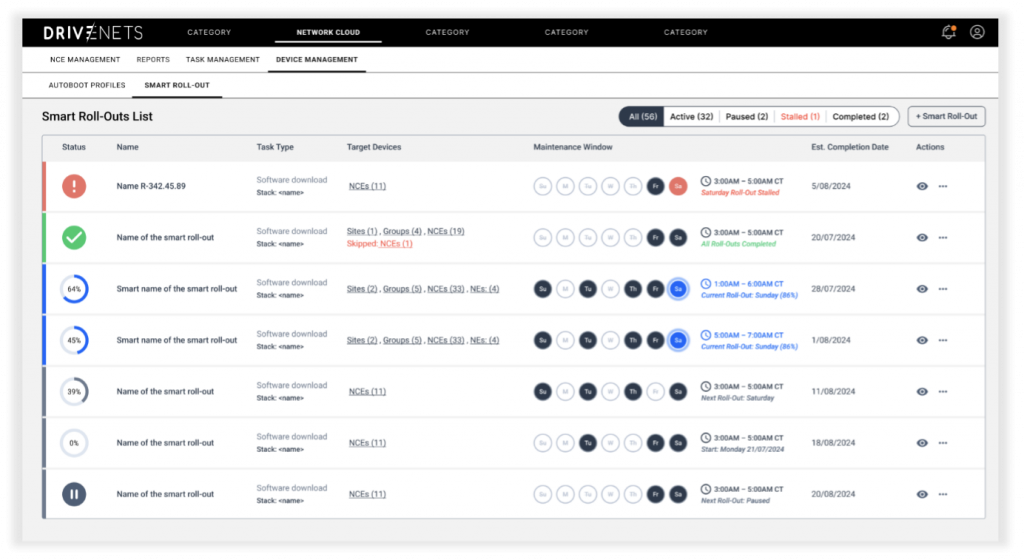|
Getting your Trinity Audio player ready...
|
Disaggregation, convergence and then automation
DriveNets has collobarated with multiple tier-1 service providers in North America, Japan, India, and Europe to build large-scale networks. Our experience highlights the necessity of simplified, open network architectures for effective automation. Trying to implement automation in complex, patchwork networks with dozens of different hardware boxes and software solutions is doomed to failure. Instead, SPs should transition to modern, unified, software-based networks with lean hardware components.
The right path to achieving this modern design starts with disaggregation, which promotes openness and eliminates vendor lock-in. Next comes convergence, which enables a leaner and simpler network design. Only then can automation be fully maximized. Since this blog post isn’t about creating a new network design , we’ll focus on automation and its ability to significantly reduce operational efforts and costs.

Modern network design – operate and maintain one converged network instead of three different networks
DriveNets Network Orchestrator (DNOR) new key features
As stated above, our tier-1 SPs typically operate more modern networks. While each SP has its own approach, they all are promoting a more simple, flexible and open network design. By utilizing our DriveNets Network Cloud solution, SPs can enjoy unique operational benefits offered by our DriveNets Network Orchestrator (DNOR).
Here are three new key features of DNOR:
- Autoboot profiles: This feature helps SPs bootstrap new white boxes directly from the factory, simplifying the process of adding new elements as fully functional routers to the network. This automation enables true zero-touch provisioning (ZTP) for the operational team, mitigating challenges associated with deploying hundreds, and sometimes thousands, of new elements into the network.
 Autoboot profiles feature – reduces manual intervention and accelerates deployment processes of new network elements
Autoboot profiles feature – reduces manual intervention and accelerates deployment processes of new network elements - Smart rollout: While autoboot focuses on provisioning new network elements, the smart rollout feature simplifies ongoing network operations. DNOR enables SPs to deploy software stacks or patches across the entire network while respecting scheduled maintenance windows. This eliminates the need for manual site-by-site software updates, allowing for automated updates of large clusters and standalone white boxes with minimal human involvement. SPs define the desired changes, and DNOR does the rest.

Smart rollout – Scheduled automatic software updates according to maintenance windows - Single source of truth (SSoT): DNOR integrates with SSoT platforms (like Nautobot or NetBox) to provide an active inventory. This significantly simplifies the process of updating network elements based on real-time network status. DNOR’s active inventory streamlines operations, reduces human errors, and enhances network resource management by providing an accurate real-time view of network assets and configurations.
DriveNets’ Distributed Disaggregated Chassis (DDC) disrupts the traditional monolithic approach, breaking large chassis into standard building blocks. Powered by cloud-native software, these blocks are used to build network elements capable of supporting any use case, from core to edge. This architecture, coupled with a wide range of open northbound interface standards, APIs, protocols, and data modules, provides an ideal foundation for introducing advanced automation tools such as those described above.
The journey towards autonomous networks
Artificial intelligence (AI) has become the latest buzzword, with many organizations eager to adopt it. For some, it’s a tactical move to impress investors, while others see genuine needs and real potential benefits. The networking industry is a prime example of a sector well-positioned to leverage AI to achieve significant operational advantages.
Although full AI integration and autonomous networks are still in the future, service providers are rightly accelerating their adoption of automation tools and features. This is crucial for managing the increasing complexity of large-scale networks and reducing operational costs.
DriveNets offers a set of solutions and features to help SPs transition their networks from human-managed to a more automated environment. The features mentioned above, along with the new disaggregated network design, represent the initial steps towards achieving a fully autonomous network with deep AI involvement.
Related content for Service Provider Routing and Network Infrastructure
DriveNets Service Provider Networking Solution
Latest Resources on AI Networking: Videos, White Papers, etc
Recent AI Networking blog posts from DriveNets AI networking infrastructure experts
White paper
DNOR – DriveNets Network Orchestrator




